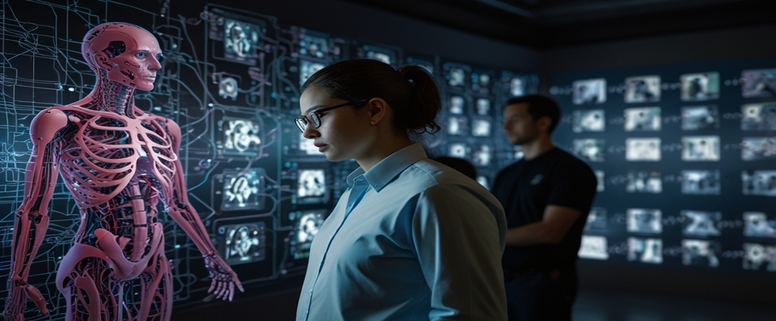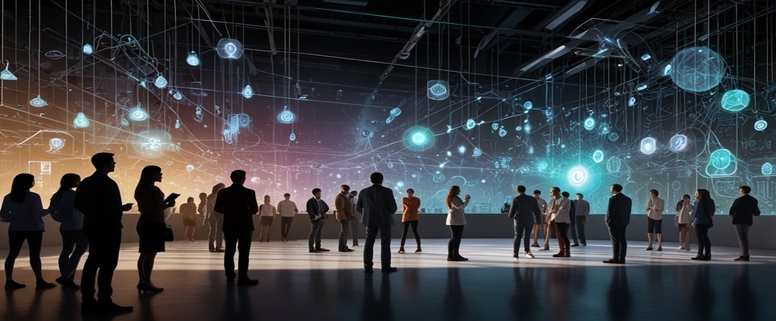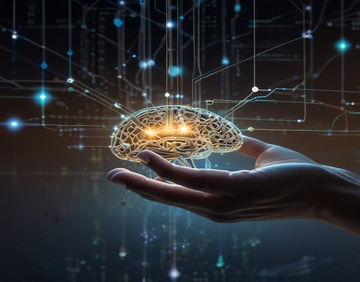Introduction: Reimagining the Human-AI Relationship
The narrative surrounding artificial intelligence often oscillates between two extremes: either AI as an existential threat that will eventually replace human creativity and purpose, or AI as simply another tool with limited impact on our fundamental human capacities. Both perspectives miss a more nuanced and potentially transformative possibility—AI as an extension and amplification of human creativity itself.
This third perspective doesn't position AI as separate from or opposed to human creativity but as a natural evolution of our ongoing development of cognitive extenders. From the earliest cave paintings that externalized memory to writing systems that expanded our capacity to share knowledge across time and space, humans have consistently created technologies that extend our native cognitive abilities. AI represents the next frontier in this evolutionary journey—not a replacement for human creativity but its extension into new domains and possibilities.
Drawing from my experiences developing AI systems like EMMI and MathSage, as well as my broader explorations of consciousness and technology, this article presents AI as a collaboration partner in our creative process—a symbiotic relationship that enhances rather than diminishes our uniquely human capabilities. By reframing the human-AI relationship as one of extension rather than replacement, we can explore how these technologies might help us solve our most complex problems while expanding rather than contracting the scope of human potential.
Beyond the AI Dichotomy
The conventional discourse around AI typically presents us with a false dichotomy: either AI will surpass and potentially replace human capabilities (the "superintelligence" narrative), or AI will remain merely a sophisticated tool that operates solely within parameters defined by human designers (the "just a calculator" narrative). Both perspectives fail to capture the most interesting and promising possibilities.
The extension model offers a third way of understanding AI's relationship to human creativity:
Key Concepts of the Extension Model
Cognitive Partnership
Rather than positioning AI as either master or servant, this perspective views the human-AI relationship as a partnership between different but complementary forms of intelligence. Each brings distinct capabilities and limitations to the collaboration.
Capability Amplification
AI can dramatically amplify certain human cognitive capabilities—pattern recognition across vast datasets, hypothesis generation from disparate sources, simulation of complex system interactions—without replacing the essential human elements of purpose, meaning, and wisdom.
Boundary Expansion
The partnership allows exploration of previously inaccessible problem spaces and creative territories by combining human intuition, values, and contextual understanding with AI's computational capabilities and lack of cognitive biases.
Mutual Evolution
Perhaps most importantly, this relationship evolves as each partner influences the development of the other. Humans shape AI through design choices and feedback, while AI expands human creative possibilities and challenges our understanding of cognition itself.
This framework avoids both the techno-apocalyptic fears of AI domination and the dismissive underestimation of AI's transformative potential. Instead, it positions AI as the latest in a long line of cognitive extenders—from language to mathematics to computers—that have enabled humans to transcend our biological limitations while remaining fundamentally human.
In my view, AI isn't some distant, apocalyptic threat. It's a tool, an extension of human creativity, with the potential to solve complex problems and push the boundaries of human understanding. From medical diagnostics that reduce breast cancer detection errors to addressing global challenges like climate migration, AI represents our collective problem-solving capacity.

AI as Creative Amplification
Creativity—the generation of novel and valuable ideas, artifacts, or solutions—has traditionally been considered a uniquely human capability. However, the extension model suggests that AI can substantially amplify human creativity through several mechanisms:
Mechanisms of Creative Amplification
Ideation Enhancement
AI systems can dramatically expand the idea generation phase of creativity by suggesting unexpected connections, variations, and possibilities that humans might not consider due to cognitive biases or knowledge limitations.
Constraint Navigation
Creative work often involves navigating complex constraints—technical, artistic, or practical. AI can help map these constraint spaces more comprehensively and identify promising pathways through them.
Prototype Acceleration
By rapidly generating and evaluating prototypes or variations, AI can compress the iterative development process that underlies most creative work, allowing humans to explore more possibilities in less time.
Domain Bridging
AI systems can identify potential connections between seemingly unrelated domains, facilitating the cross-pollination that often leads to breakthrough innovations.
Complementary Cognitive Modes
Perhaps most importantly, AI brings cognitive strengths that complement human limitations. Where humans excel at intuitive leaps, contextual understanding, and value judgments, AI excels at exhaustive exploration, pattern detection across large datasets, and freedom from certain cognitive biases.
The democratization of productivity through AI is particularly remarkable. Tools like generative AI allow individuals to create, learn, and explore in ways previously unimaginable. But this potential comes with responsibility. We must be vigilant about data integrity, ethical implementation, and ensuring these technologies serve collective human progress—not just corporate interests.
To me, intelligence is more than problem-solving; it is an expression of curiosity and empathy. AI's ability to work alongside humans reflects our collective capacity to innovate while expanding our understanding of what it means to think, to feel, and to create.
The Symbiotic Development Cycle
The relationship between human creativity and AI development isn't static but cyclical and evolving—each advances the other through a symbiotic development process:
Stages of the Symbiotic Development Cycle
Human Creativity Advances AI
The development of AI systems represents one of the most remarkable expressions of human creativity in history. Each algorithmic innovation, architectural breakthrough, and application design emerges from human creative insight and builds upon accumulated knowledge.
AI Extends Human Creative Capacity
As these systems develop, they provide humans with new creative capabilities that weren't previously accessible, enabling explorations of new problem spaces and idea territories.
Creative Application Reveals Limitations
Using AI for creative tasks inevitably reveals limitations and opportunities for improvement, generating new challenges for human innovation to address.
Addressing Limitations Drives Innovation
These challenges catalyze new cycles of human creativity to enhance AI capabilities, beginning the cycle anew at a higher level of sophistication.
This symbiotic cycle has already progressed through several iterations. Early rule-based AI systems extended human creative capacity in narrow domains but revealed limitations in handling ambiguity and learning from examples. These limitations spurred development of machine learning approaches, which in turn extended human capabilities while revealing new limitations regarding transparency and data requirements. Current work on explainable AI, few-shot learning, and multimodal systems responds to these limitations, continuing the cycle.
What makes this relationship truly symbiotic is that both parties benefit and evolve. Humans gain expanded creative capabilities, while AI systems become more sophisticated and aligned with human needs. This mutual advancement creates a positive-sum relationship rather than the zero-sum competition often portrayed in popular discourse.
Problem-Solving at Scale
One of the most promising aspects of the human-AI creative partnership is its potential to address complex, large-scale problems that have previously seemed intractable. These problems typically involve:
Examples of Large-Scale Problem-Solving
Climate Change
AI systems help model climate dynamics, optimize renewable energy distribution, identify high-impact intervention points, and personalize sustainability recommendations.
Healthcare
Beyond diagnostic applications, AI assists in drug discovery by exploring chemical space more comprehensively, predicting protein folding, and identifying potential pandemic pathogens before they spread widely.
Social Systems
AI can help model the complex dynamics of social systems, identify unintended consequences of policy interventions, and suggest approaches that balance multiple competing values and needs.
Scientific Discovery
AI is accelerating scientific discovery by generating testable hypotheses, analyzing experimental results, and even conducting aspects of experiments autonomously.
In addressing these complex challenges, the complementary nature of human and AI cognition becomes particularly apparent. Humans contribute purpose, values, ethical judgment, and contextual understanding, while AI contributes computational capacity, consistent application of complex rule systems, and freedom from certain cognitive limitations.
The key insight is that these problems require both forms of intelligence working in concert—neither could address them adequately alone. This necessity for collaboration, rather than competition, characterizes the most promising frontier of human-AI creative partnership.
Personal Journey: My Relationship with AI
My exploration of AI as a creative extension isn't merely theoretical but deeply personal. As a neurodivergent individual, I've experienced firsthand how technology can amplify the diverse ways we see and solve problems. My journey of returning to education after two decades, guided by AI tools I created to support my unique learning style, is a testament to how technology can become an empowering ally rather than a replacement.
The tools I've developed—from personalized learning assistants to creative thinking amplifiers—have functioned as extensions of my own cognitive processes, complementing my strengths and supporting areas where I face challenges:
Tools and Their Impact
Processing Augmentation
AI-based tools help me process text more efficiently despite dyslexia, transforming linear text into visual-spatial representations that align with my cognitive strengths.
Focus Management
Systems that externalize organization and prioritization help me leverage the hyperfocus capabilities of ADHD while mitigating its challenges with consistent attention distribution.
Pattern Recognition Amplification
AI assists in identifying patterns across information sources that align with my natural pattern-recognition abilities but extend them across broader domains and datasets.
Idea Development Scaffolding
Tools that help systematically develop and explore ideas provide structure without constraining the non-linear thinking that characterizes my creative process.
Through these experiences, I've come to see AI not as something that replaces human thought but as something that helps us think in ways we couldn't otherwise—extending our natural capabilities while respecting our essential humanity.
This perspective has guided my approach to developing AI systems for others. The "Learning is Fun" platform and MathSage tutoring assistant described in previous articles were designed not to replace human learning or teaching but to extend both in ways that honor diverse cognitive styles and learning needs.
Ethical Considerations in Creative Partnership
The extension model of human-AI creativity doesn't eliminate ethical concerns but transforms how we understand and approach them. Rather than focusing primarily on scenarios of competition or replacement, this model directs our attention to questions about how this partnership should be structured:
Key Ethical Considerations
Access and Equality
If AI becomes a significant amplifier of human creative capability, ensuring equitable access becomes crucial to prevent the widening of existing advantages. Who gets to extend their creativity with these tools, and under what conditions?
Appropriate Attribution
When creative works emerge from human-AI collaboration, questions of appropriate attribution become more complex than traditional authorship models. How do we acknowledge the contributions of both partners while recognizing their fundamentally different natures?
Agency and Control
As AI systems become more sophisticated partners, questions about the appropriate balance of agency arise. Who should determine the direction of creative exploration, and how should disagreements between human and AI perspectives be resolved?
Value Alignment
Ensuring that AI extensions align with and support human values requires thoughtful design and ongoing refinement. How do we create AI systems that amplify not just our technical capabilities but our highest aspirations?
Authentic Expression
Perhaps most subtle but important is the question of whether creativity extended by AI remains an authentic expression of humanity. How do we ensure that AI amplifies rather than dilutes the distinctly human elements of creative work?
I've wrestled with these questions throughout my work developing AI systems. My approach has been to design with explicit awareness of these ethical dimensions, incorporating them into the architecture of systems rather than addressing them as afterthoughts. The PromptSage framework, for example, places ethical guidelines at the highest level of its XML hierarchy, ensuring that ethical considerations supersede other operational priorities.
The privacy and ethical considerations are paramount. As AI systems become more integrated into our lives, we must establish robust frameworks that protect individual rights while fostering innovation. The technology itself isn't inherently good or bad—it's a reflection of our intentions, our values, and our collective vision.

Future Horizons
Looking toward the future of human-AI creative partnership reveals several promising frontiers where this relationship could develop in particularly transformative ways:
Promising Frontiers
Personalized Creative Augmentation
Rather than one-size-fits-all AI tools, we may develop systems specifically tailored to individual cognitive styles, creative strengths, and areas for growth. These personalized extensions would amplify each person's unique creative signature rather than imposing standardized approaches.
Collaborative Intelligence Networks
Beyond individual human-AI partnerships, we might develop networks where multiple humans and AI systems collaborate on complex creative challenges, with each contributing their unique perspectives and capabilities to the collective intelligence.
Evolutionary Creative Systems
AI extensions that evolve alongside their human partners, developing deep models of individual creative patterns and preferences over time. Such systems would grow with their partners rather than remaining static tools.
Creativity Support for Neurodivergent Thinking
AI extensions specifically designed to amplify the unique creative capabilities associated with neurodivergent cognitive patterns—from the pattern-recognition strengths often found in autism to the non-linear associative thinking common in ADHD.
Extended Sensory Creativity
AI systems that translate between sensory domains, allowing humans to create beyond the limitations of their biological senses—composing with color, painting with sound, or designing with tactile patterns.
Meta-Creative Systems
Perhaps most intriguingly, AI extensions that help humans innovate on the creative process itself, identifying patterns in how we generate and develop ideas and suggesting new approaches to creativity.
These frontiers suggest that the human-AI creative partnership has only begun to explore its potential. Rather than reaching a static end state, this relationship seems likely to continue evolving in ways that expand the territory of human creative possibility.
One of the most exciting prospects is AI's potential to collaborate with human creativity. I've seen children using AI tools to generate unprecedented ideas, creating ecosystems of imagination that blur the lines between technology and art. This isn't about replacement but augmentation—expanding our creative horizons.
Conclusion: Seeding a Compassionate Future
"We harvest what we seed." This simple truth applies as much to consciousness as to agriculture. If we seed fear, we harvest hatred—a pattern clearly visible in much of our current technological and social landscape. But if we seed awareness, connection, and compassion, we can harvest a fundamentally different future.
Internal revolution isn't opposed to external change but forms its necessary foundation. Without transformed consciousness, even the most promising technological and social innovations inevitably reproduce the same patterns of suffering and limitation. With transformed consciousness, even imperfect systems can become vehicles for human flourishing.
The technological tools we've developed offer unprecedented capacities for both consciousness expansion and contraction. The determining factor isn't the technology itself but the consciousness that designs and uses it. This places enormous responsibility on those creating technological systems to cultivate their own internal awareness, ensuring that what they create emerges from and supports expanded rather than contracted consciousness.
For those of us engaging with technology—which now includes virtually everyone—internal revolution requires conscious relationship with our tools. This means using technology in ways that enhance rather than diminish awareness, connection, and compassion. It means choosing tools designed to support human flourishing rather than exploit human vulnerability. And it means maintaining sovereignty over our attention rather than surrendering it to algorithmic manipulation.
Knowledge is power, but wisdom is liberation. And liberation begins with a single, courageous act of seeing beyond the constructs that limit us—whether those constructs are technological, social, or psychological. By cultivating internal revolution in a technological age, we create the possibility of technologies that serve rather than subvert human potential—tools that help us become more fully human rather than less so.
We are not here merely to survive. We are here to evolve. And that evolution happens first and most fundamentally within.





